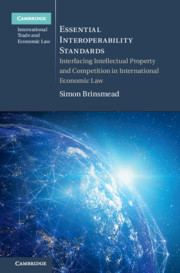 Essential Interoperability Standards
Essential Interoperability Standards from Part I - Foundations and Problems
Published online by Cambridge University Press: 26 October 2021
This chapter outlines the nature of standards, with a particular focus on interoperability or compatibility standards. Standards in concept are introduced. A typology of standards is provided, which distinguishes between ‘interoperability’ or ‘compatibility’ standards and other types of standards, as well as between formal and de facto standards. The concept of an interoperability or compatibility standard is then examined in more detail. The work then examines and discusses some noteworthy interoperability standards, both from within and outside the field of information and communications technology (ICT). The key fora for the creation of interoperability standards are surveyed. The highly variegated nature of the interoperability standards-setting landscape is emphasized, as well as the relative ease with which standard-setting initiatives can migrate from one forum to another. The economic characteristics of interoperability standards are examined, in particular demand-side economies of scale or ‘network effects’, both direct and indirect (the latter being of primary importance to the work).
To save this book to your Kindle, first ensure [email protected] is added to your Approved Personal Document E-mail List under your Personal Document Settings on the Manage Your Content and Devices page of your Amazon account. Then enter the ‘name’ part of your Kindle email address below. Find out more about saving to your Kindle.
Note you can select to save to either the @free.kindle.com or @kindle.com variations. ‘@free.kindle.com’ emails are free but can only be saved to your device when it is connected to wi-fi. ‘@kindle.com’ emails can be delivered even when you are not connected to wi-fi, but note that service fees apply.
Find out more about the Kindle Personal Document Service.
To save content items to your account, please confirm that you agree to abide by our usage policies. If this is the first time you use this feature, you will be asked to authorise Cambridge Core to connect with your account. Find out more about saving content to Dropbox.
To save content items to your account, please confirm that you agree to abide by our usage policies. If this is the first time you use this feature, you will be asked to authorise Cambridge Core to connect with your account. Find out more about saving content to Google Drive.